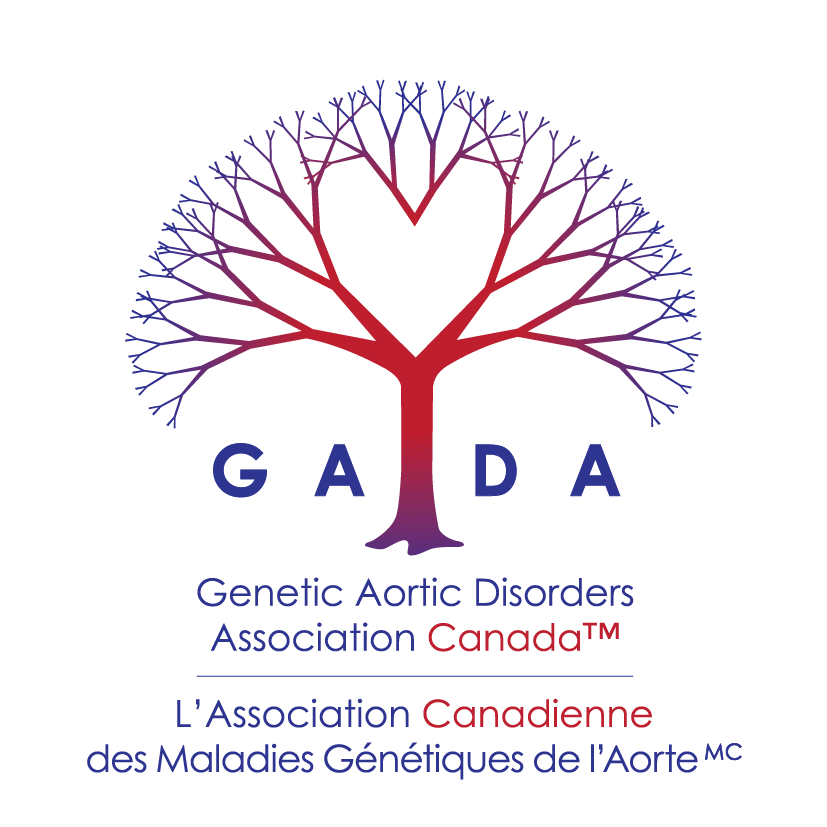Quick Links
About HTAD / GAD
Heritable thoracic aortic disease (HTAD) refers to thoracic aortic disease in patients and families in whom there is a confirmed gene mutation (genetic aortic disorder) or at least a strong suspicion for a genetic factor, based on clinical features or family history (and hence heritable), that confers a high risk for thoracic aortic aneurysms and dissections (TAAD).
Approximately 20% of individuals, who do not have one of the known genetic syndromes but have a family history (known gene mutation or unknown genetic cause) of TAAD, are diagnosed to have Familial TAAD (FTAAD).
Depending on the presence or absence of manifestations in other organ systems, H-TAD can be further subdivided into syndromic (manifestations in aorta, vascular and other organ systems) and non-syndromic (manifestations in only aorta and vascular systems). Known genetic syndromes that have a risk of TAAD include Marfan syndrome (MFS), vascular Ehlers Danlos syndrome (vEDS) and Loeys-Dietz syndrome (LDS).
For both clinical entities (syndromic and non-syndromic forms) multiple underlying gene defects have been identified. With current techniques, mutation detection rates are significantly higher in syndromic than in non-syndromic forms – up to 95% in Marfan syndrome versus 15-20% in non-syndromic HTAD.
Most HTAD are inherited in an autosomal dominant manner with reduced penetrance and variable expressivity. The variable expressivity includes the age of disease onset, type of TAAD presentation or manifestations in other organ systems and whether there is a risk of other cardiovascular conditions.
Other cardiovascular conditions associated with HTAD could include: aneurysms and dissections of other large and small arteries, presence of congenital heart defects: PDA- patent ductus arteriosus and BAV- bicuspid aortic valve, and early onset stroke or coronary artery disease.
Children of a parent with HTAD have up to a 50% chance to develop a thoracic aortic aneurysm and/or dissection or other vascular conditions.
Establishing Diagnosis For Proper Management of HTAD
In contrast to patients with syndromic HTAD, who may come to medical attention through visible outward features, patients with non-syndromic forms are often diagnosed on presentation with aortic events, which can be life-threatening acute aortic dissections.
Establishing a diagnosis for HTAD, by identifying the specific genetic cause, can help determine proper clinical management of TAAD-affected individuals and their relatives at risk; including early detection, monitoring for aneurysms or other vascular conditions, and deciding medical treatment.
To establish a diagnosis and risk assessment for HTAD, the following must be done:
- Cardiac Examination including echocardiography to detect aortic root dilation, mitral valve prolapse, bicuspid aortic valve and congenital heart disease
- Vascular imaging includes computed tomography (CT) or magnetic resonance imaging (MRI) to detect dilation beyond the aortic root and aneurysms and tortuosity of major branching vessels
- Medical history and physical examination help identify visible features of syndromic forms of TAAD
- Family history should include a three-generation family history with attention to aortic or other cardiovascular disease through examination of medical records, post-mortem records and aortic histopathology
- Molecular genetic testing is recommended in affected individuals. Molecular genetic testing in family members is only recommended in those cases where a mutation is identified in the proband.
Genetic testing approaches include a combination of gene-targeted testing (multi-gene panel or single-gene testing) and genomic testing (comprehensive genomic sequencing). Gene-targeted and exome/genome testing is applicable to the proband only.
Identifying the specific genetic cause for TAAD also has the potential to predict and optimize the timing of elective aortic surgery to prevent acute aortic dissections, further reducing the high morbidity and mortality associated with TAAD.
Extensive research is being done by the Montalcino Aortic Consortium using an internationally active patient registry, which will help improve our understanding of different HTAD-related gene mutations and establish gene- and mutation-specific recommendations for surgical repair and clinical management.
HTAD Genetic Risk Factors
Over the last decade, a growing number of gene mutations have been identified that increase the risk of TAAD. Currently, the majority of these genes encode proteins involved in vascular smooth muscle cell contraction and adhesion to the extracellular matrix or TGF-β signaling pathway
The following genes (proteins) are known to have a strong predisposition to TAAD:
NOTE: As research deciphers the association of additional gene mutations with TAAD, the new genes will be added to the list below.
Extracellular Matrix (ECM Proteins)
FBN1 (Protein: Fibrillin-1) – Marfan syndrome
LOX (Protein: Lysyl oxidase)
COL3A1 (Protein: Collagen 3α1) – Ehlers Danlos syndrome vascular type
TGF- β signalling pathway
TGFB2 (Protein: TGF-β2) – Loeys-Dietz syndrome
TGFB3 (Protein: TGF-3) – Rienhoff syndrome or Loeys-Dietz syndrome type 5
TGFBR1 (Protein: TGF-β receptor type 1) – Loeys-Dietz syndrome
TGFBR2 (Protein: TGF-β receptor type 2) – Loeys-Dietz syndrome
SMAD3 (Protein: SMAD3) – Aneurysm osteoarthritis syndrome; Loeys-Dietz syndrome
SKI (Protein: Sloan Kettering proto-oncoprotein) - Shprintzen-Goldberg syndrome
Vascular smooth muscle cell (SMC) contractility
ACTA2 (Protein: Smooth muscle α-actin) – Multisystemic smooth muscle dysfunction
MYH11 (Protein: Smooth muscle myosin heavy chain)
MYLK (protein: Myosin light chain kinase)
PRKG1 (Protein: Type 1 cGMP-dependent protein kinase)
Neural crest migration
NOTCH1 (Protein: NOTCH1) – Bicuspid Aortic Valve Disease
Unknown
FOXE3 (Protein: Forkhead box 3)
MAT2A (Protein: Methionine adenosyltransferase II alpha)
SLC2A10 (Protein: Glucose transporter 10) - Arterial tortuosity syndrome
References
- Milewicz DM, Regalado E, Heritable Thoracic Aortic Disease Overview. Gene Reviews. Last revision December 14 2017
- Mulder B.J.M., van de Laar I.M.B.H., De Backer J. (2017) Heritable Thoracic Aortic Disorders. In: Baars H., Doevendans P., Houweling A., van Tintelen J. (eds) Clinical Cardiogenetics. Springer, Cham
- Milewicz DM, Regalado E, Using Genetics for Personalized Management of Heritable Thoracic Aortic Disease: How Do We Get There? Thorac Cardiovasc Surg. 2015 February; 149(2 0): S3–S5.

